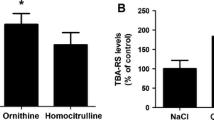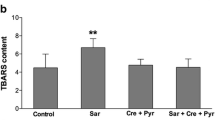Abstract
Sparse-fur (spf) mouse is the ideal animal model to study the neuropathology of congenital ornithine transcarbamylase (OTC) deficiency. Our current hypothesis implies that an ammonia-induced depletion of energy metabolism in the spf mouse, could be due to a reduction in the activities of the enzymes of the electron transport chain and a treatment with acetyl-L-carnitine could normalize this abnormality. We also hypothesized that there might be a differential degree of inhibition in synaptosomal and non-synaptic mitochondria, for the enzymes of the electron transport chain, caused by congenital hyperammonemia. We have therefore measured the activities of NADH-cytochrome C oxidoreductase, succinate cytochrome C oxidoreductase and cytochrome C oxidase in synaptosomes and non-synaptic mitochondria, isolated from spf mice and CD-1 controls with and without acetyl-L-carnitine treatment. Our results indicate a significant reduction (19–34%) in the activities of these complexes in synaptosomes in untreated spf mice, whereas in non-synaptic mitochondria, there was a tendency for the activities to decrease. Acetyl-L-carnitine treatment enhanced these activities (15–64%) for all the three enzyme complexes and its effect was more prominent on succinate cytochrome C oxidoreductase activity (64%). These studies point out that: (a) ammonia-induced disturbances in the energy metabolism could be more pronounced in neuronal mitochondria, and (b) the effect of acetyl-L-carnitine on the restoration of cerebral ATP in hyperammonemia could be through an enhancement of the activities of various electron transport chain enzymes.
Similar content being viewed by others
REFERENCES
Brusilow, S. W., and Maestri, N. E. 1996. Urea cycle disorders: Diagnosis, Pathophysiology and Therapy Adv. Pediatr. 43:127–170.
Batshaw, M. L. 1994. Inborn errors of urea synthesis. Ann. Neurol. 35:133–141.
Brusilow, S. W., and Horwich, A. L. 1995. Urea cycle enzymes. Pages 1187–1232, in Scriver, C. R., Beuadet, A. L., Sly, W. S., and Valle, D. (eds.), Metabolic and Molecular Bases of Inherited Disease, McGraw Hill, New York.
Seiler, N. 1993. Is ammonia a pathogenetic factor in Alzheimer's disease? Neurochem. Res. 18:235–245.
Fisman, M., Gordon, B., Feleki, V., Helmes, E., Appell, J., and Rabheru, K. 1985. Hyperammonemia in Alzheimer's disease. Am. J. Psychiatry. 142:71–73.
Beal, M. F. 1992. Does impairment of energy metabolism result in excitotoxic neuronal death in neurodegenerative illnesses? Ann. Neurol. 31:119–130.
Qureshi, I. A., Letarte, J., and Ouellet, R. 1979. Ornithine transcarbamylase deficiency in mutant mice. I. Studies on the characterization of enzyme defect and suitability as animal model of human disease. Pediatr. Res. 13:807–811.
Veres, G., Gibbs, R. A., Scherer, S. E., and Caskey, C. T. 1987. The molecular basis of the sparse-fur mouse mutation. Science. 237:415–417.
Ratnakumari, L., Qureshi, I. A., and Butterworth, R. F. 1992. Effects of congenital hyperammonemia on the cerebral and hepatic levels of the intermediates of energy metabolism in spf mice. Biochem. Biophys. Res. Commun. 184:746–751.
Ratnakumari, L., Qureshi, I. A., and Butterworth, R. F. 1993. Effect of sodium benzoate on cerebral and hepatic energy metabolites in spf mice with congenital hyperammonemia. Biochem. Pharmacol. 45:137–146.
Rama Rao, K. V., Mawal, Y. R., and Qureshi, I. A. 1997. Progressive decrease of cerebral cytochrome C oxidase activity in sparse fur mice: role of acetyl-L-carnitine in restoring the ammonia-induced cerebral energy depletion. Neurosci. Lett. 224:83–86.
Qureshi, I. A. 1989. Congenital hyperammonemia, Model-No 235, Supplemental update, 1989. in Capen, C. C., Jones, T. C., and Migaki, G. (eds.), Hand Book: Animal Models of Human Disease. Fascicule 17. Registry of Comparative Pathology, Armed Forces Institute of Pathology, Washington, D.C.
Ratnakumari, L., Audet, A., Qureshi, I. A., and Butterworth, R. F. 1995. Na+,K+-ATPase activities are increased in brain in both congenital and acquired hyperammonemic syndromes. Neurosci. Lett. 197:89–92.
Ratnakumari, L., Qureshi, I. A., and Butterworth, R. F. 1994. Evidence for cholinergic neuronal loss in brain in congenital ornithine transcarbamylase deficiency. Neurosci. Lett. 178:63–65.
Ratnakumari, L., Qureshi, I. A., and Butterworth, R. F. 1995. Loss of [3H]-MK 801 binding sites in brain in congenital ornithine transcarbamylase deficiency. Metab. Brain Dis. 10:249–255.
Kosenko, E., Kaminsky, Y., Grau, E., Minana, M. D., Marcaida, G., Grisolia, S., and Felipo, V. 1994. Brain ATP depletion induced by acute ammonia intoxication in rats is mediated by activation of NMDA receptor and Na+,K+-ATPase. J. Neurochem. 63:2172–2178.
Marcaida, G., Minana, M. D., Burgal, M., Grisolia, S., and Felipo, V. 1995. Ammonia prevents activation of NMDA receptors by glutamate in rat cerebellar neuronal cultures. Eur. J. Neurosci. 7:2389–2396.
Peterson, C., Giguere, J. F., Cotman, C. W., and Butterworth, R. F. 1990. Selective loss of N-methyl-D-aspartate-sensitive L-[3H]-glutamate binding sites in rat brain following portacaval anastomosis. J. Neurochem. 55:386–390.
Katanuma, N., and Okada, M. 1963. Respiratory inhibition of TCA cycle and control of glutamic acid synthesis by ammonia in rat liver mitochondria. Biochem. Biophys. Res. Commun. 12:252–256.
Worcel, A., and Erecinska, M. 1962. Mechanism of inhibitory action of ammonia on the respiration of rat-liver mitochondria. Biochim. Biophys, Acta. 65:27–33.
Faff-Michalak, L., and Albrecht, J. 1991. Aspartate aminotransferase, malate dehydrogenase and pyruvate carboxylase activities in rat cerebral synaptic and non-synaptic mitochondria: effects of in vitro treatment with ammonia, hyperammonemia and hepatic encephalopathy. Metab. Brain. Dis. 6:187–197.
Kosenko, E., Felipo, V., Montoliu, C., Grisolia, S., and Kaminsky, Y. 1996. Effects of acute hyperammonemia in vivo on oxidative metabolism in nonsynaptic rat brain mitochondria. Metab. Brain. Dis. 12:69–82.
Rosenthal, R. E., Williams, R., Bogaert, Y. E., Getson, P. R., and Fiskum, G. 1992. Prevention of postischemic canine neurological injury through potentiation of brain energy metabolism by acetyl L-carnitine. Stroke. 23:1312–1318.
Paradies, G., Ruggiero, F. M., Petrosillo, G., Gadaleta, M. N., and Quagliariello, E. 1994. Effect of aging and acetyl L-carnitine on the activity of cytochrome oxidase and adenine nucleotide translocase in rat heart mitochondria. FEBS Lett. 350:213–215.
Spagnoli, A., Lucca, U., Menasce, G., and Bandera, L., et al. 1991. Long-term acetyl-L-carnitine treatment in Alzheimer's disease. Neurology. 41:1726–1732.
Gadaleta, M. N., Petruzzella, V., Daddabbo, L., Olivieri, C., Fracasso, F., Polosa, P. L., and Cantatore, P. 1994. Mitochondrial DNA transcription and translation in aged rats. Effect of acetyl-L-carnitine. Annal. New York Acad. Sci. 150–160.
De Robertis, E., Pellgrino de Iraldi, A., de L. Rodriguez de Lores Armaiz, G., and Salganicoff, L. 1962. Cholinergic and non-cholinergic nerve endings in rat brain. I. Isolation and sub-cellular distribution of acetylcholine and acetylcholinesterase. J. Neurochem. 9:23–35.
Turpeenoja, L., Villa, R. F., Magri, G., and Stella, G. A. M. 1988. Changes of mitochondrial membrane proteins in rat cerebellum during aging. Neurochem. Res. 13:859–865.
Lowry, O. H., Rosebrough, N. J., Farr, A. L., and Randall, R. J. 1951. Protein measurements with the Folin-phenol reagent. J. Biol. Chem. 193:265–275.
Zheng, X., Shoffner, J. M., Lott, M. T., Voljavec, A. S., Krawiecki, N. S., Winn, K., and Wallace, D. C. 1989. Evidence in a lethal infantile mitochondrial disease for a nuclear mutation affecting respiratory complexes I and IV. Neurology. 39:1203–1209.
Chagnon, P., Bétard, C., Robitaille, Y., Cholette, A., and Gauvreau, V. 1995. Distribution of brain cytochrome oxidase activity in various neurodegenerative disease. Neuro. Report. 6:711–715.
Cafè, C., Torri, C., Gatti, S., Adinolfi, D., Gaetani, P., Rodriguez Y Baena, R., and Marzatico, F. 1994. Changes in non-synaptosomal and synaptosomal mitochondrial membrane-linked enzymatic activities after transient cerebral ischemia. Neurochem. Res. 19:1551–1555.
Drewes, L. R., and Leino, R. L. 1985. Neuron-specific mitochondrial degeneration induced by hyperammonemia and octanoic acidemia. Brain Res. 340:211–218.
Hindfelt, B., Plum, F., and Duffy, T. E. 1977. Effect of acute ammonia intoxication on cerebral metabolism in rats with porta caval shunts. J. Clin. Invest. 59:386–396.
Ratnakumari, L., and Murthy, Ch. R. K. 1989. Activities of pyruvate dehydrogenase, enzymes of citric acid cycle and aminotransferases in sub-cellular fractions of cerebral cortex in normal and hyperammonemic rats. Neurochem. Res. 14:221–228.
Makar, T. K., Nedergaard, M., Preuss, A., Gelbard, A. S., Perumal, A. S., and Cooper, A. J. L. 1994. Vitamin E, ascorbate, glutathione, glutathione disulfide, and enzymes of glutathione metabolism in cultures of chick astrocytes and neurons: Evidence that astrocytes play an important role in anti-oxidative process in the brain. J. Neurochem. 62:45–53.
Raps, S. P., Lai, J. C. K., Hertz, L., and Cooper, J. L. 1989. Glutathione is present in high concentrations in cultured astrocytes but not in cultured neurons. Brain Res. 493:398–401.
Author information
Authors and Affiliations
Rights and permissions
About this article
Cite this article
Qureshi, K., Rao, K.V.R. & Qureshi, I.A. Differential Inhibition by Hyperammonemia of the Electron Transport Chain Enzymes in Synaptosomes and Non-Synaptic Mitochondria in Ornithine Transcarbamylase-Deficient spf-Mice: Restoration by Acetyl-L-Carnitine. Neurochem Res 23, 855–861 (1998). https://doi.org/10.1023/A:1022406911604
Issue Date:
DOI: https://doi.org/10.1023/A:1022406911604




